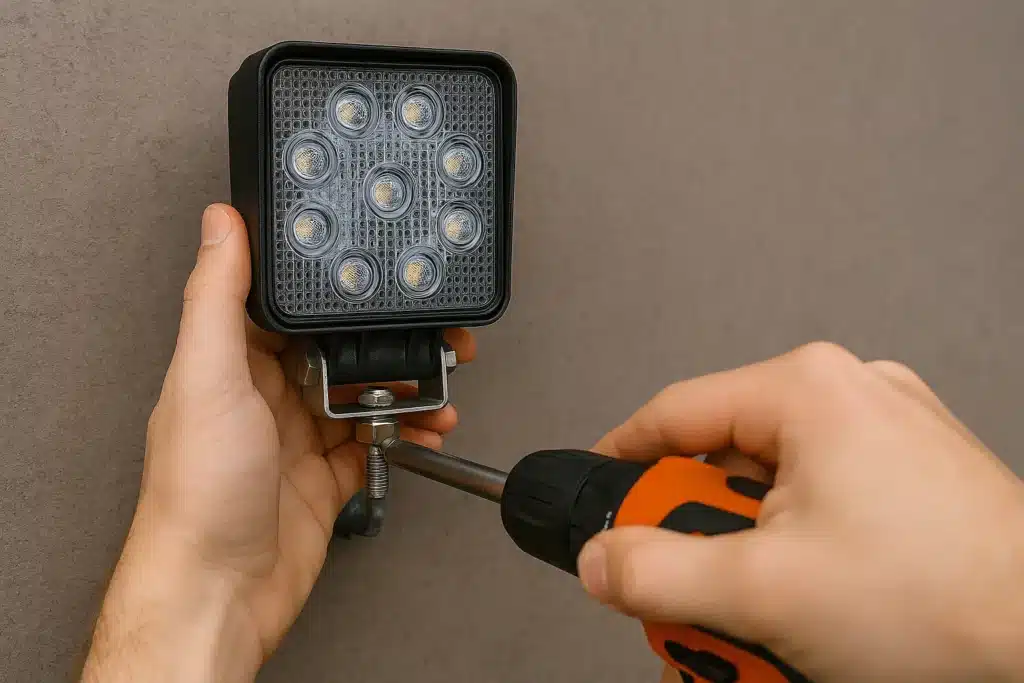The lighting of a work vehicle plays a crucial role in both work efficiency and safety during operations. Especially when working in dark or poorly lit areas, LED work lights offer an efficient way to create optimal lighting conditions. The following article deals with the installation of LED work lights using the example of vans and workshop vehicles and provides helpful tips and advice for successful retrofitting.

Suitable Installation Locations
Roof
Roof installation offers the advantage of illuminating a wide area. LED headlights like our models with flexible mounting are particularly effective in this position and enable comprehensive lighting of the work area. However, a professional vehicle builder should perform the installation to avoid damage to the roof and ensure secure wiring.
Side Surfaces and Rear Area
Whether you are carrying out loading operations at night or performing maintenance work on the side of your vehicle, mounting LED work lights on the side surfaces and at the rear can provide real added value. Our IP69K-protected model in particular has proven itself in this regard.
Interior
LED work lights in the interior can be particularly advantageous for workshop vehicles, where work is often carried out in poor lighting conditions. The use of compact models with sufficient light intensity is recommended here to optimally illuminate the work area.
Technical Requirements
Power Supply
Depending on the vehicle and desired performance, a power supply of 12V or 24V is required. When selecting LED work lights, care should be taken to ensure that they are compatible with the voltage available in the vehicle.
Wiring and Fusing
The wiring of the headlights must be carried out professionally to avoid short circuits or overheating. Appropriate fusing of the system is essential and should be carried out by a specialist.
Switch Positioning
The positioning of the switch for the work lights should be chosen so that it is easily accessible to the vehicle operator. It may be advisable to consult an expert here.
Legal Aspects
In addition to the technical challenges, legal aspects must also be considered when installing work lights. In Germany, it is important that the headlights have ECE approval and may be used according to the road traffic regulations (StVO). To avoid glare, the headlights should be adjusted so that they do not blind other road users. More detailed information can be found on the official pages of unece.org and gesetze-im-internet.de.
Typical Installation Errors and How to Avoid Them
Typical errors when installing LED work lights are faulty wiring, inadequate fusing, and incorrect alignment of the headlights. These errors can be avoided through careful planning, precise instructions, and expertise.
Selection Tips
When selecting the right work light for your vehicle, attention should be paid not only to the required performance and technical requirements but also to quality. Robust models with flexible mounting, high vibration resistance, and protection class IP69K from our range meet these requirements and are specifically designed for use in vans and workshop vehicles.
When making a decision, attention should also be paid to a compact design and that the work light has ECE approval, thus avoiding legal problems during installation.
The installation of LED work lights on vans requires precision. For general guidance on selecting and installing headlights, read our comprehensive guide to LED work lights. If you encounter problems, such as with reversing lights, you’ll find our solutions to common problems.
FAQ
What factors should be considered when selecting LED work lights for a van?
Power supply, vibration resistance, protection class, compact design, and ECE approval are some of the most important factors that should be considered when making a selection.
Is it important to install LED work lights professionally?
Yes, professional installation is very important to ensure that the device functions safely and effectively and that it complies with legal regulations.
